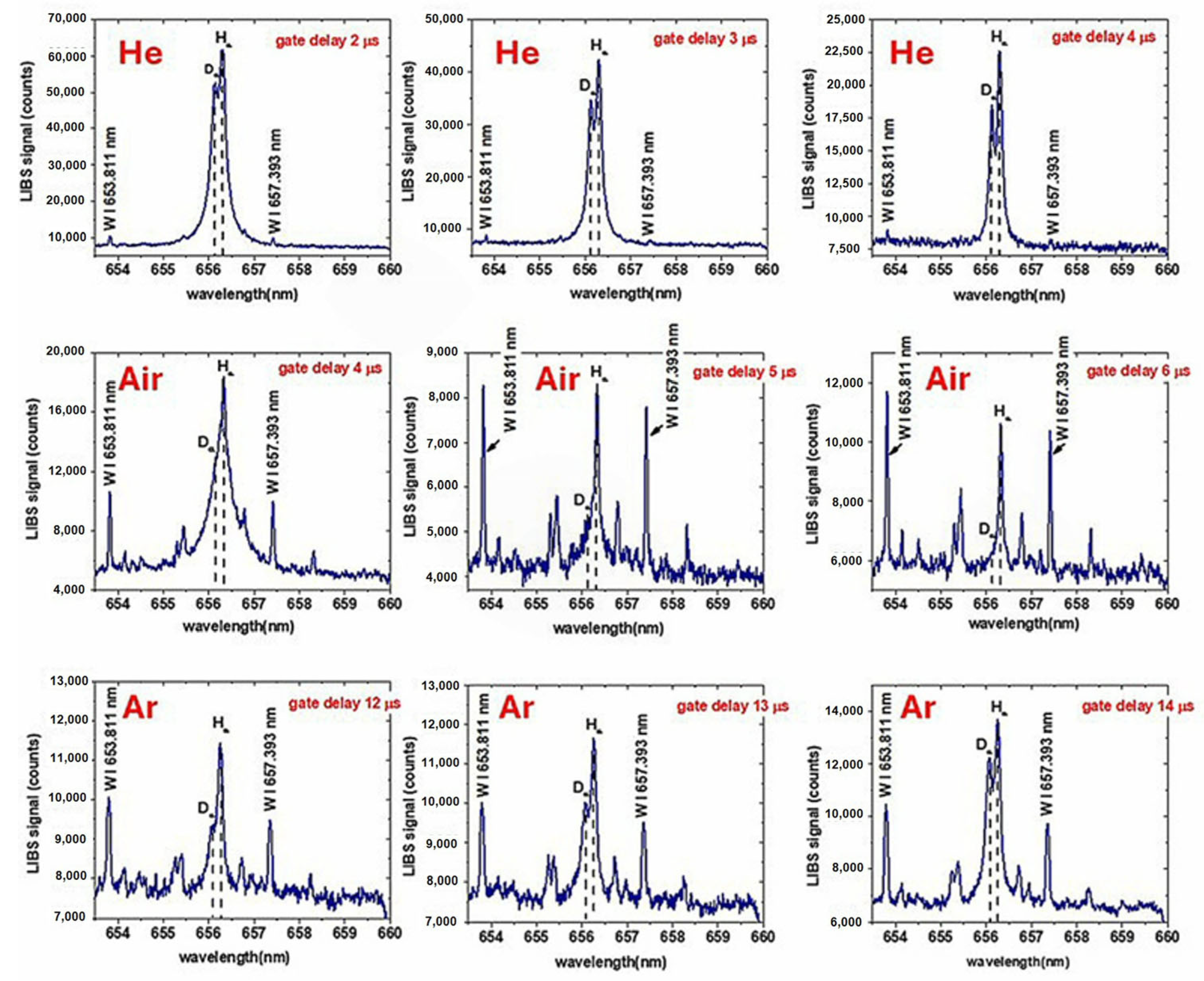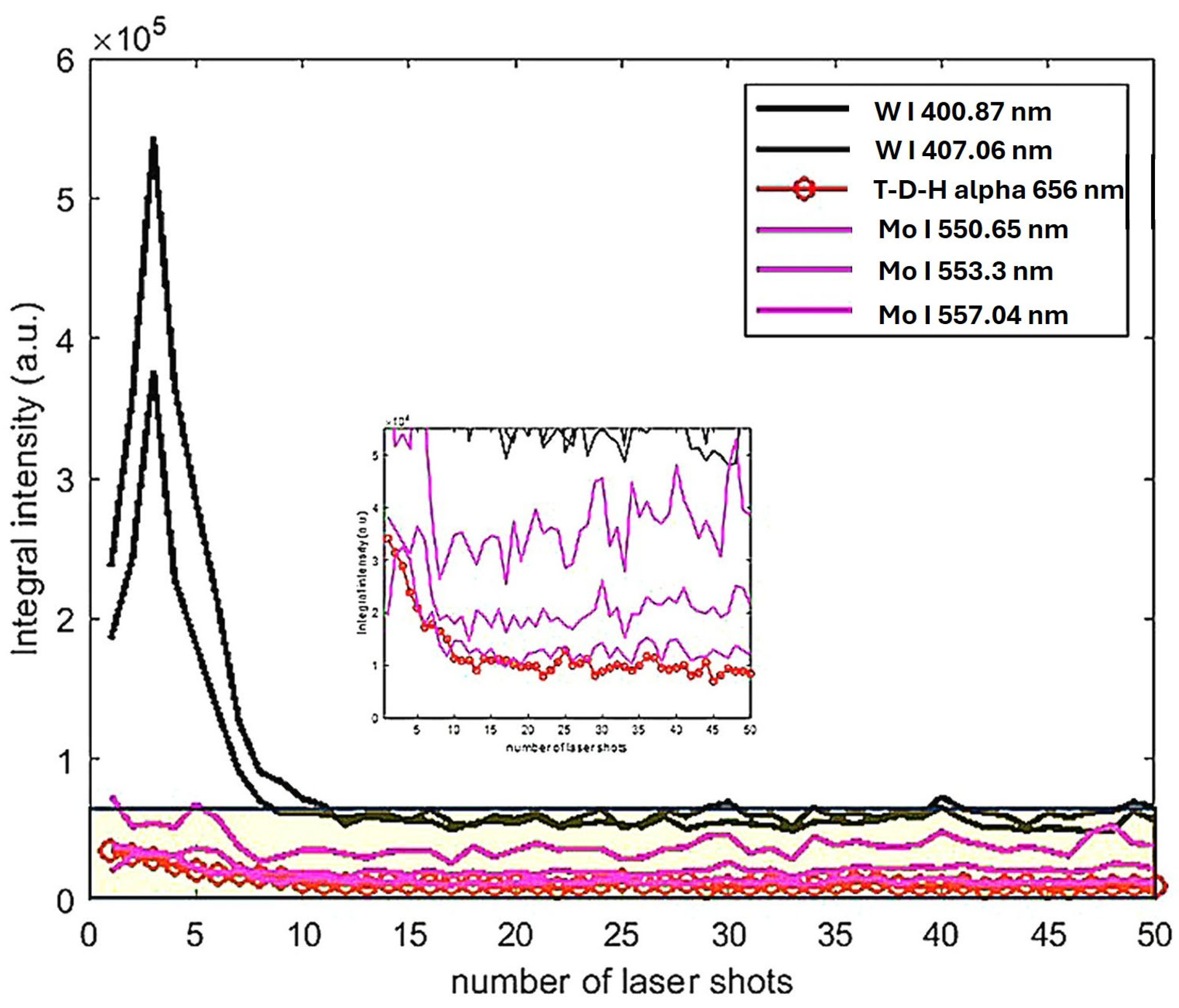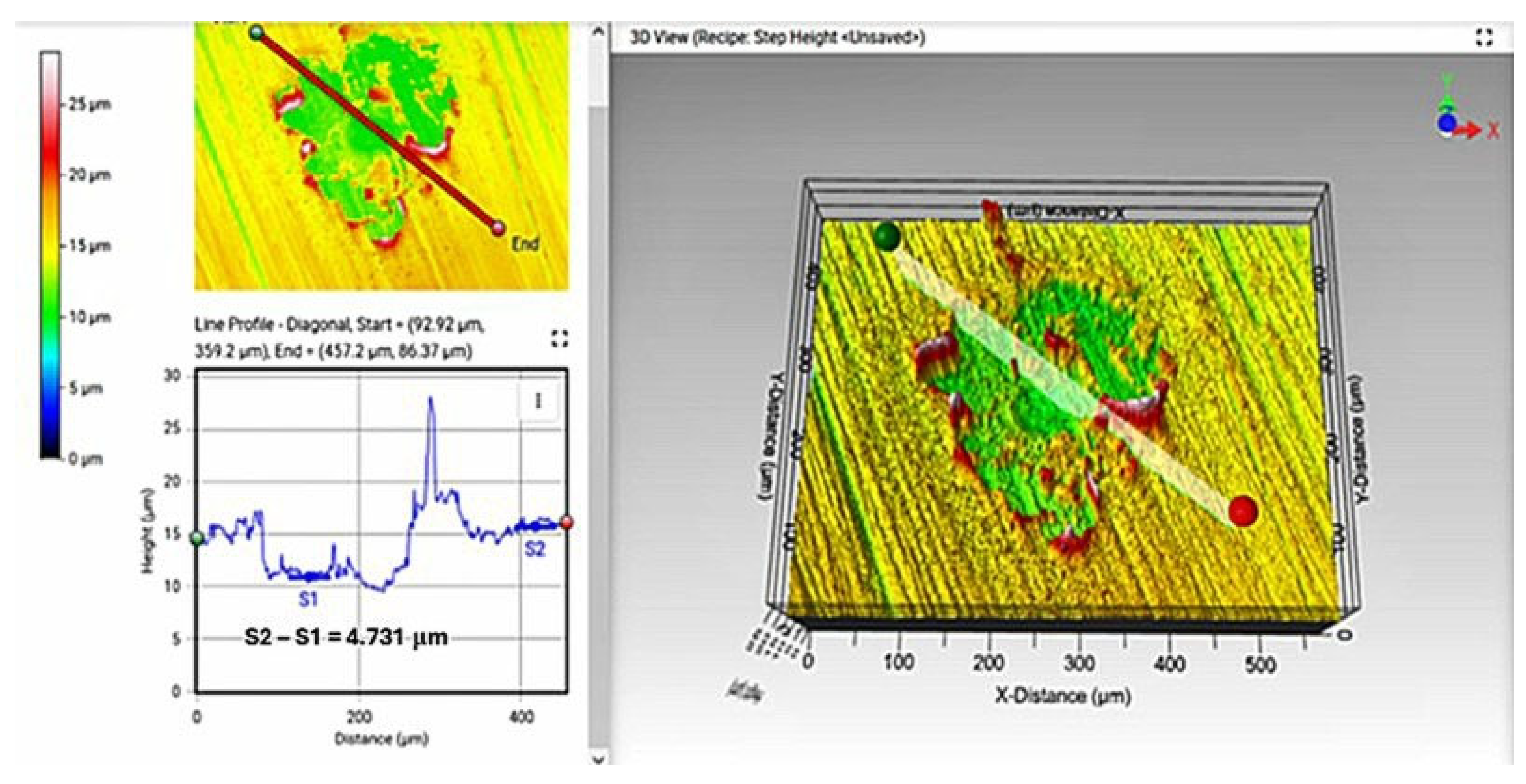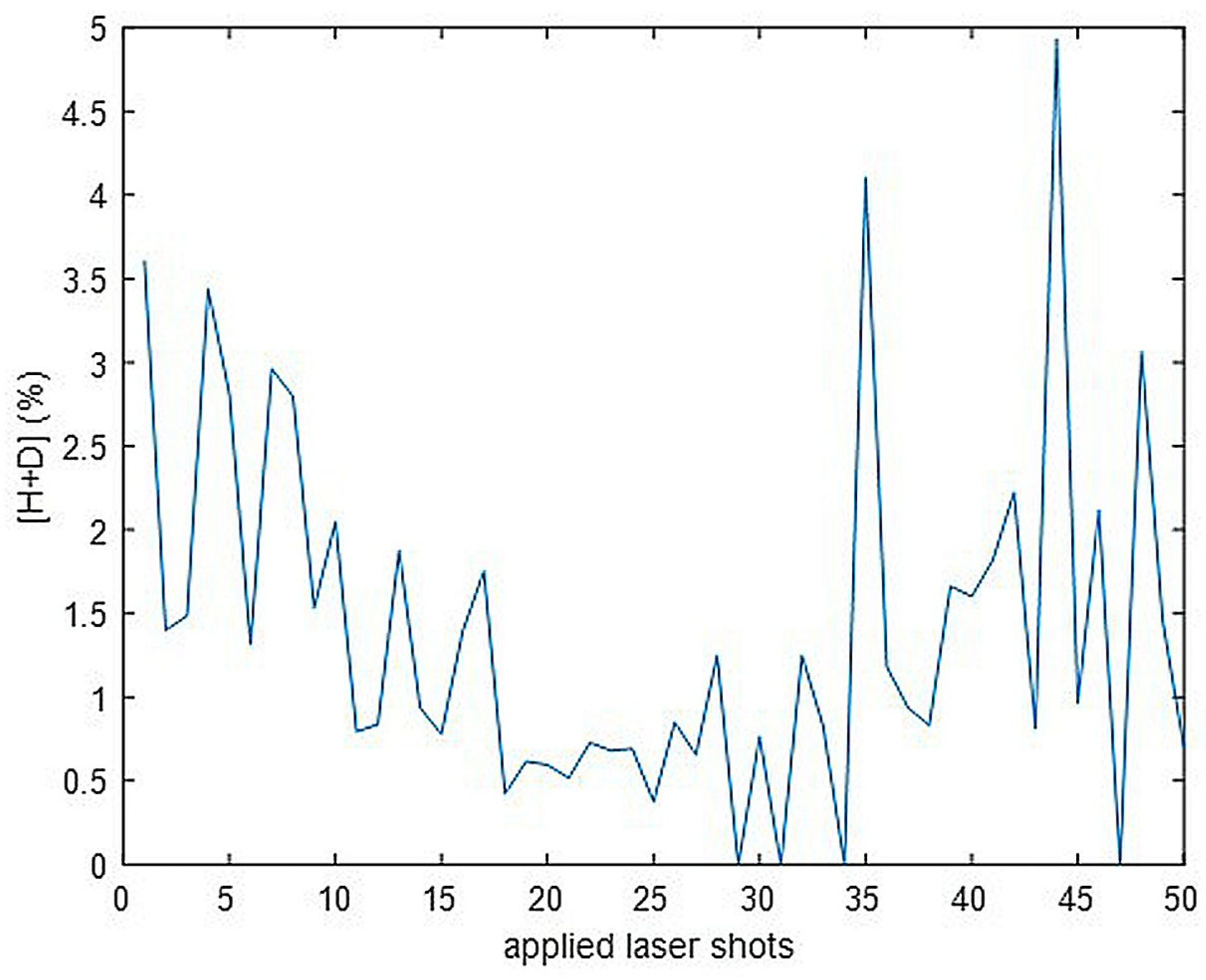Optimization of the LIBS Technique in Air, He, and Ar at Atmospheric Pressure for Hydrogen Isotope Detection on Tungsten Coatings
Abstract
1. Introduction
2. Materials and Methods
3. Results and Discussion
3.1. Detection of D on the W-D Sample
3.2. Depth Profiling Analysis
3.3. Calibration-Free Analysis
4. Conclusions
Author Contributions
Funding
Data Availability Statement
Acknowledgments
Conflicts of Interest
References
- Roth, J.; Tsitrone, E.; Loarer, T.; Philipps, V.; Brezinsek, S.; Loarte, A.; Counsell, G.F.; Doerner, R.P.; Schmid, K.; Ogorodnikova, O.V.; et al. Tritium inventory in ITER plasma-facing materials and tritium removal procedures. Plasma Phys. Control Fusion 2008, 50, 103001. [Google Scholar] [CrossRef]
- Pitts, R.A.; Loarte, A.; Wauters, T.; Dubrov, M.; Gribov, Y.; Köchl, F.; Pshenov, A.; Zhang, Y.; Artola, J.; Bonnin, X.; et al. Plasma-wall interaction impact of the ITER re-baseline. Nucl. Mater. Energy 2025, 42, 101854. [Google Scholar] [CrossRef]
- Schmid, K.; Wauters, T. Full W ITER: Assessment of expected W erosion and implications of boronization on fuel retention. Nucl. Mater. Energy 2024, 41, 101789. [Google Scholar] [CrossRef]
- Widdowson, A.; Coad, J.P.; Zayachuk, Y.; Jepu, I.; Alves, E.; Catarino, N.; Corregidor, V.; Mayer, M.; Krat, S.; Likonen, J.; et al. Evaluation of tritium retention in plasma facing components during JET tritium operations. Phys. Scr. 2021, 96, 124075. [Google Scholar] [CrossRef]
- Radziemski, L.J.; Cremers, D.A. Handbook of Laser-Induced Breakdown Spectroscopy; John Wiley: New York, NY, USA, 2006; ISBN 0-470-09299-8. [Google Scholar]
- van der Meiden, H.J.; Almaviva, S.; Butikova, J.; Dwivedi, V.; Gasior, P.; Gromelski, W.; Hakola, A.; Jiang, X.; Jõgi, I.; Karhunen, J.; et al. Monitoring of tritium and impurities in the first wall of fusion devices using a LIBS based diagnostic. Nucl. Fusion 2021, 61, 125001. [Google Scholar] [CrossRef]
- Almaviva, S.; Caneve, L.; Colao, F.; Lazic, V.; Maddaluno, G.; Mosetti, P.; Palucci, A.; Reale, A.; Gasior, P.; Gromelski, W.; et al. LIBS measurements inside the FTU vacuum vessel by using a robotic arm. Fusion Eng. Des. 2021, 169, 112638. [Google Scholar] [CrossRef]
- Hu, Z.; Bai, X.; Wu, H.; Hai, R.; Ding, F.; Imran, M.; Li, C.; Ding, H.; Luo, G.-N. Quantitative analysis of impurities deposited on the Plasma-Facing Components of EAST tokamak using a portable LIBS device. Nucl. Mater. Energy 2024, 41, 101785. [Google Scholar] [CrossRef]
- Maddaluno, G.; Almaviva, S.; Caneve, L.; Colao, F.; Lazic, V.; Laguardia, L.; Gasior, P.; Kubkowska, M. Detection by LIBS of the deuterium retained in the FTU toroidal limiter. Nucl. Mater. Energy 2019, 18, 208–211. [Google Scholar] [CrossRef]
- Jõgi, I.; Paris, P.; Ristkok, J.; Roldán, A.M.; Bhat, P.G.; Veis, P.; Karhunen, J.; Almaviva, S.; Gromelski, W.; Dinca, P.; et al. Laser-induced breakdown spectroscopy for helium detection in beryllium coatings. Nucl. Mater. Energy 2024, 39, 101677. [Google Scholar] [CrossRef]
- Liu, S.; Li, C.; Wu, H.; Li, L.; Liu, J.; Wu, D.; Hai, R.; Ding, H. Experimental and model study of LIBS depth profile for multilayer deposition materials. Spectrochim. Acta B 2023, 209, 106783. [Google Scholar] [CrossRef]
- Ciucci, A.; Corsi, M.; Palleschi, V.; Rastelli, S.; Salvetti, A.; Tognoni, E. New Procedure for Quantitative Elemental Analysis by Laser-Induced Plasma Spectroscopy. Appl. Spectrosc. 1999, 53, 960–964. [Google Scholar] [CrossRef]
- Matějíček, J.; Dejarnac, R.; Ruset, C.; Grigore, E.; Cvrček, L.; Walter, J.; Perry, F. Development of tungsten coatings on Inconel superalloy for COMPASS upgrade plasma-facing components. Nucl. Mater. Energy 2025, 42, 101844. [Google Scholar] [CrossRef]
- Kim, Y.C.; Jang, S.H.; Oh, S.J.; Lee, H.C.; Chung, C.W. Two-dimensional-spatial distribution measurement of electron temperature and plasma density in low temperature plasmas. Rev. Sci. Instrum. 2013, 84, 053505. [Google Scholar] [CrossRef] [PubMed]
- Corsi, M.; Cristoforetti, G.; Giuffrida, M.; Hidalgo, M.; Legnaioli, S.; Palleschi, V.; Salvetti, A.; Tognoni, E.; Vallebona, C. Three-dimensional analysis of laser induced plasmas in single and double pulse configuration. Spectrochim. Acta B 2004, 59, 723–735. [Google Scholar] [CrossRef]
- Aguilera, J.A.; Aragon, C. A comparison of the temperatures and electron densities of laser-produced plasmas obtained in air, argon, and helium at atmospheric pressure. Appl. Phys. A 1999, 69, S475–S478. [Google Scholar] [CrossRef]
- Nazar, F.; Shazia, B.; Khaliq, M. Effect of ambient gas conditions on laser-induced copper plasma and surface morphology. Phys. Scr. 2012, 85, 015702. [Google Scholar] [CrossRef]
- Vors, E.; Gallou, C.; Salmon, L. Laser-induced breakdown spectroscopy of carbon in helium and nitrogen at high pressure. Spectrochim. Acta B 2008, 63, 1198–1204. [Google Scholar] [CrossRef]
- Lee, Y.-I.; Song, K.; Cha, H.-K.; Lee, J.-M.; Park, M.-C.; Lee, G.-H.; Sneddon, J. Influence of atmosphere and irradiation wavelength on copper plasma emission induced by excimer and Q-switched Nd:YAG laser ablation. Appl. Spectrosc. 1997, 51, 959–964. [Google Scholar] [CrossRef]
- Królicka, A.; Maj, A.; Łój, G. Application of Laser-Induced Breakdown Spectroscopy for Depth Profiling of Multilayer and Graded Materials. Materials 2023, 16, 6641. [Google Scholar] [CrossRef]
- Abbass, Q.; Ahmed, N.; Ahmed, R.; Baig, M.A. A Comparative Study of Calibration Free Methods for the Elemental Analysis by Laser Induced Breakdown Spectroscopy. Plasma Chem. Plasma Process. 2016, 36, 1287–1299. [Google Scholar] [CrossRef]
- Cristoforetti, G.; De Giacomo, A.; Dell, M.; Legnaioli, S.; Tognoni, E.; Palleschi, V.; Omenetto, N. Local Thermodynamic Equilibrium in Laser-Induced Breakdown Spectroscopy: Beyond the McWhirter criterion. Spectrochim. Acta B 2010, 65, 86–95. [Google Scholar] [CrossRef]
- Völker, T.; Gornushkin, I.B. Extension of the Boltzmann plot method for multiplet emission lines. J. Quant. Spectrosc. Radiat. Transf. 2023, 310, 108742. [Google Scholar] [CrossRef]
- Zhang, N.; Ou, T.; Wang, M.; Lin, Z.; Lv, C.; Qin, Y.; Li, J.; Yang, H.; Zhao, N.; Zhang, Q. A Brief Review of Calibration-Free Laser-Induced Breakdown Spectroscopy. Front. Phys. 2022, 10, 887171. [Google Scholar] [CrossRef]
- Aguilera, J.A.; Aragon, C. Multi-element Saha–Boltzmann and Boltzmann plots in laser-induced plasmas. Spectrochim. Acta B 2007, 62, 378–385. [Google Scholar] [CrossRef]
- Thouin, J.; Benmouffok, M.; Freton, P.; Gonzalez, J.J. Interpretation of Stark broadening measurements on a spatially integrated plasma spectral line. Eur. Phys. J. Appl. Phys. 2022, 97, 87. [Google Scholar] [CrossRef]
- Dimitrijević, M.S. Forty Years of the Applications of Stark Broadening Data Determined with the Modified Semiempirical Method. Data 2020, 5, 73. [Google Scholar] [CrossRef]
- Burger, M.; Hermann, J. Stark broadening measurements in plasmas produced by laser ablation of hydrogen containing compounds. Spectrochim. Acta B 2016, 122, 118–126. [Google Scholar] [CrossRef]
- Urbina Medina, I.A.; Carneiro, D.D.; Rocha, S.; Farias, E.E.; Bredice, F.O.; Palleschi, V. Branching Ratio Method for Assessing Optically Thin Conditions in Laser-Induced Plasmas. Appl. Spectrosc. 2021, 75, 774–780. [Google Scholar] [CrossRef]
- NIST Atomic Spectra Database (ver. 5.12). Available online: https://physics.nist.gov/asd (accessed on 22 April 2025).
- Fujimoto, T.; McWhirter, R.W.P. Validity criteria for local thermodynamic equilibrium in plasma spectroscopy. Phys. Rev. A 1990, 42, 6588–6601. [Google Scholar] [CrossRef]
- Nishijima, D.; Doerner, R.P. Stark width measurements and Boltzmann plots of W I in nanosecond laser-induced plasmas. J. Phys. D 2015, 48, 325201. [Google Scholar] [CrossRef]






| Background Gas | Delay (μs) | Rs (Dα − Hα) | Rs_theor (Tα − Dα) |
|---|---|---|---|
| He | 2 | 0.95 | 0.275 |
| He | 3 | 1.15 | 0.333 |
| He | 4 | 1.52 | 0.44 |
| Ar | 12 | 1.12 | 0.32 |
| Ar | 13 | 1.15 | 0.33 |
| Ar | 14 | 1.31 | 0.38 |
| λ (nm) | Aki (10−8 s) | gk | Ek (eV) | I1/I2 (Theo.) | I1/I2 (Exp.) |
|---|---|---|---|---|---|
| 653.811 | 2.7 × 10−3 | 9 | 4.354 | 0.975 | 1.09 |
| 657.393 | 9.9 × 10−3 | 3 | 4.487 |
Disclaimer/Publisher’s Note: The statements, opinions and data contained in all publications are solely those of the individual author(s) and contributor(s) and not of MDPI and/or the editor(s). MDPI and/or the editor(s) disclaim responsibility for any injury to people or property resulting from any ideas, methods, instructions or products referred to in the content. |
© 2025 by the authors. Licensee MDPI, Basel, Switzerland. This article is an open access article distributed under the terms and conditions of the Creative Commons Attribution (CC BY) license (https://creativecommons.org/licenses/by/4.0/).
Share and Cite
Almaviva, S.; Baiamonte, L.; Pistilli, M. Optimization of the LIBS Technique in Air, He, and Ar at Atmospheric Pressure for Hydrogen Isotope Detection on Tungsten Coatings. J. Nucl. Eng. 2025, 6, 22. https://doi.org/10.3390/jne6030022
Almaviva S, Baiamonte L, Pistilli M. Optimization of the LIBS Technique in Air, He, and Ar at Atmospheric Pressure for Hydrogen Isotope Detection on Tungsten Coatings. Journal of Nuclear Engineering. 2025; 6(3):22. https://doi.org/10.3390/jne6030022
Chicago/Turabian StyleAlmaviva, Salvatore, Lidia Baiamonte, and Marco Pistilli. 2025. "Optimization of the LIBS Technique in Air, He, and Ar at Atmospheric Pressure for Hydrogen Isotope Detection on Tungsten Coatings" Journal of Nuclear Engineering 6, no. 3: 22. https://doi.org/10.3390/jne6030022
APA StyleAlmaviva, S., Baiamonte, L., & Pistilli, M. (2025). Optimization of the LIBS Technique in Air, He, and Ar at Atmospheric Pressure for Hydrogen Isotope Detection on Tungsten Coatings. Journal of Nuclear Engineering, 6(3), 22. https://doi.org/10.3390/jne6030022










